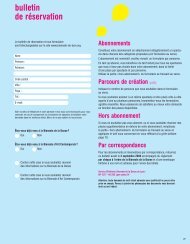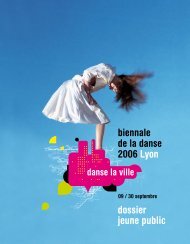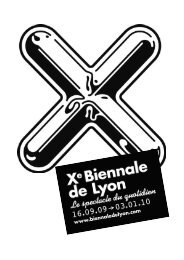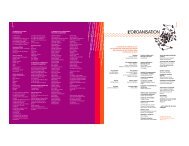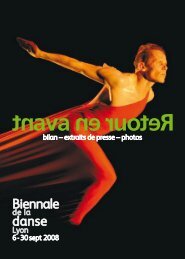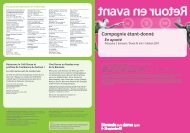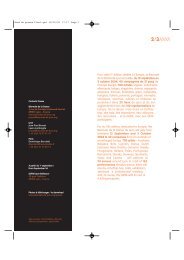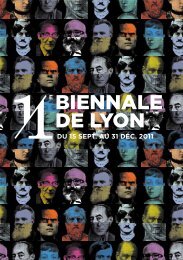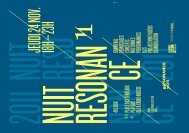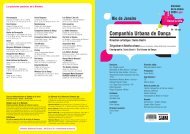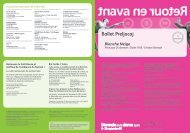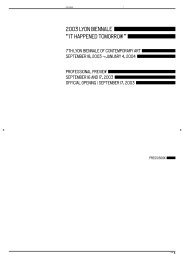Retour en Avant / Past Forward Biennale de la Danse Lyon - France
Retour en Avant / Past Forward Biennale de la Danse Lyon - France
Retour en Avant / Past Forward Biennale de la Danse Lyon - France
- No tags were found...
You also want an ePaper? Increase the reach of your titles
YUMPU automatically turns print PDFs into web optimized ePapers that Google loves.
Maison <strong>de</strong> <strong>la</strong> <strong>Danse</strong> -Studio Jorge DonnLundi 29 19h30« Malice »Mardi 30 10h et 14h30sco<strong>la</strong>iresMardi 30 19h30« Malice »Durée : 1hDavid Rol<strong>la</strong>nd ChorégraphiesLes lecteurs (chorégraphiescollectives)Pièce pour 2 danseurs - Création 2004Direction artistique et chorégraphie :David Rol<strong>la</strong>ndA partir <strong>de</strong> 8 ansDavid Rol<strong>la</strong>ndParallèlem<strong>en</strong>t à ses étu<strong>de</strong>s <strong>de</strong> pharmacie, David Rol<strong>la</strong>ndétudie <strong>la</strong> danse contemporaine, jazz et c<strong>la</strong>ssique.Après avoir obt<strong>en</strong>u son diplôme d’état <strong>de</strong> professeur<strong>de</strong> danse, il travaille <strong>en</strong> tant qu’interprète avec leschorégraphes Odile Duboc, Béatrice Massin, B<strong>la</strong>nca Li,Mié Coquempot, Laura Scozzi et François Grippeau.En 1997, il fon<strong>de</strong> avec Jean-François Courti<strong>la</strong>t et Jean-François Guillon, tous <strong>de</strong>ux p<strong>la</strong>stici<strong>en</strong>s, <strong>la</strong> galerie ipsofacto située à Nantes, espace d’exposition qui accueilledans ses murs <strong>la</strong> jeune création contemporaine tout <strong>en</strong>effectuant <strong>de</strong>s échanges avec <strong>de</strong>s structures comparables<strong>en</strong> <strong>France</strong> et à l’étranger. En 1999, riche <strong>de</strong> ces différ<strong>en</strong>tesexpéri<strong>en</strong>ces, David Rol<strong>la</strong>nd se tourne vers untravail chorégraphique dans le cadre <strong>de</strong> <strong>la</strong> compagnieipso facto danse, association qu’il crée avec Ange<strong>la</strong>Fagnano, danseuse et chorégraphe. Depuis 2004, ausein <strong>de</strong> David Rol<strong>la</strong>nd Chorégraphies, il interroge <strong>la</strong>communication non verbale et <strong>la</strong> perception que nous<strong>en</strong> avons. Il crée ainsi <strong>de</strong>s pièces chorégraphiques,performances, dispositifs ou spectacles qui provoqu<strong>en</strong>tun questionnem<strong>en</strong>t sur les co<strong>de</strong>s <strong>en</strong> faisant souv<strong>en</strong>tappel à un esprit ludique. De plus, ces travaux, souv<strong>en</strong>tqualifiés d’hybri<strong>de</strong>s ou transdisciplinaires remett<strong>en</strong>tsouv<strong>en</strong>t <strong>en</strong> jeu <strong>la</strong> p<strong>la</strong>ce du spectateur.Les lecteursToutes les personnes prés<strong>en</strong>tes sont invitées à suivreune partition sous <strong>la</strong> forme d’un carnet distribué àchacun. Ces carnets conti<strong>en</strong>n<strong>en</strong>t <strong>de</strong>s informations trèssimples; une ban<strong>de</strong> sonore indique <strong>la</strong> page sur <strong>la</strong>quellese trouve l’action à effectuer. Postures, dép<strong>la</strong>cem<strong>en</strong>tset gestes infimes sont effectués p<strong>en</strong>dant un tempsfixé par <strong>la</strong> ban<strong>de</strong> sonore au rythme <strong>de</strong> 30 secon<strong>de</strong>sà 2 minutes par action. Les spectateurs ignor<strong>en</strong>t etdécouvr<strong>en</strong>t au fur et à mesure du spectacle qu’ils n’ontpas forcém<strong>en</strong>t tous le même carnet puisque 4 types <strong>de</strong>partitions sont, <strong>en</strong> effet, distribuées. Certaines actionsprovoqu<strong>en</strong>t un mouvem<strong>en</strong>t <strong>de</strong> masse, tandis qued’autres induis<strong>en</strong>t <strong>de</strong>s micro-situations. D’autres <strong>en</strong>coreinvit<strong>en</strong>t le « lecteur » à être spectateur <strong>de</strong> <strong>la</strong> chorégraphieproposée par les autres groupes ; le temps d’uneou <strong>de</strong>ux pages.David Rol<strong>la</strong>ndIn parallel to his pharmacy <strong>de</strong>gree, David Rol<strong>la</strong>nd studiedcontemporary, jazz and c<strong>la</strong>ssical dance. Having obtained hisstate diploma in dance teaching, he worked as a performerwith choreographers Odile Duboc, Béatrice Massin, B<strong>la</strong>nca Li,Mié Coquempot, Laura Scozzi and François Grippeau. In 1997,with visual artists Jean-François Courti<strong>la</strong>t and Jean-FrançoisGuillon, he foun<strong>de</strong>d Galerie Ipso Facto in Nantes, an exhibitionspace that hosts young contemporary creators and conductsexchanges with simi<strong>la</strong>r v<strong>en</strong>ues in <strong>France</strong> and abroad. In 1999,building on these experi<strong>en</strong>ces, Rol<strong>la</strong>nd turned to choreographywith Compagnie Ipso Facto <strong>Danse</strong>, a non-profit outfit that heset up with dancer / choreographer Ange<strong>la</strong> Fagnano. Since2004, with David Rol<strong>la</strong>nd Chorégraphies, he has be<strong>en</strong> exploringnon-verbal communication and how we perceive it. Hecreates choreographic pieces, performances, instal<strong>la</strong>tions andshows that prompt questions about co<strong>de</strong>s and oft<strong>en</strong> have ap<strong>la</strong>yful streak. In addition, these works, regu<strong>la</strong>rly <strong>de</strong>scribed ashybrid or transdisciplinary, oft<strong>en</strong> chall<strong>en</strong>ge the spectator’s role.Les lecteursEveryone in the audi<strong>en</strong>ce is giv<strong>en</strong> a booklet – a score they areinvited to follow. The booklets contain very simple information,and a soundtrack indicates the page showing theactions. Poses, movem<strong>en</strong>ts and tiny gestures are performedfor a duration dictated by the soundtrack, from 30 seconds totwo minutes per action. As the show proceeds, the spectatorsrealise they don’t all have the same booklet; in fact, there arefour types. Some actions prompt a mass movem<strong>en</strong>t; othersinduce micro-situations; others still invite the “rea<strong>de</strong>r” tostand back for a couple of pages and watch the choreographyperformed by the other groups.82



